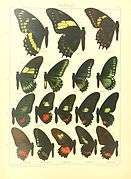Mimoides protodamas
Mimoides protodamas is a species of butterfly in the family Papilionidae. The common name is false polysticto, with reference to the similarity of this species with Battus polystictus.
| Mimoides protodamas | |
|---|---|
| Mounted specimen on display at Museo di Scienze Naturali Enrico Caffi, Bergamo | |
| Scientific classification | |
| Kingdom: | |
| Phylum: | |
| Class: | |
| Order: | |
| Family: | |
| Tribe: | |
| Genus: | |
| Species: | M. protodamas |
| Binomial name | |
| Mimoides protodamas (Godart , 1819) | |
| Synonyms | |
| |
Description
Mimoides protodamas has a wingspan reaching 70–80 millimetres (2.8–3.1 in). It is a black butterfly with rounded apex and concave outer edge of the forewings, while the outer edge of the hindwings is scalloped. The dorsal sides of the wings shows a series of whitish-bluish markings.
Description from Seitz
P. protodamas Godt. (= hyperion Hbn). Forewing with yellowish area consisting of 3 large patches, or with 1 or 2 rows of spots; hindwing with yellowish grey-blue band; forewing beneath without basal spots, hindwing with 3. The scent-organ of the male wanting. Larva black, with grey and white, partly yellow stripes, the thorax dotted with white and yellow. Thoracic horn of the pupa rather thin. Two individual forms of the butterfly are known: in f. protodamas Godt. the forewing has two rows of spots, the upper ones of which are more or less merged; in f choridamas Boisd. (13b) the forewing has a very large cell-spot and two discal patches, also large. — The butterfly is entirely Brazilian; it is found from Minas Geraes to Rio Grande do Sul; but the f. choridamas does not appear to extend so far south, being only known to us from the provinces of Rio de Janeiro and Minas Geraes.[1]
Distribution
This species can be found in the Neotropical ecozone, in Argentina, Brazil and Paraguay.
Gallery
 Illustration from Jacob Hübner's Sammlung exotischer Schmetterlinge Vol. 2 (1821)
Illustration from Jacob Hübner's Sammlung exotischer Schmetterlinge Vol. 2 (1821) Illustration from Jacob Hübner's Sammlung exotischer Schmetterlinge Vol. 2 (1821)
Illustration from Jacob Hübner's Sammlung exotischer Schmetterlinge Vol. 2 (1821)- Mimoides protodamas on display at the Museo de La Plata
 Seitz Plate 13
Seitz Plate 13
References
- Seitz, A. ed. Band 1: Abt. 1, Die Großschmetterlinge des palaearktischen Faunengebietes, Die palaearktischen Tagfalter,
1909, 379 Seiten, mit 89 kolorierten Tafeln (3470 Figuren)

- Collins, N. Mark; Morris, Michael G. (1985). Threatened Swallowtail Butterflies of the World: The IUCN Red Data Book. Gland & Cambridge: IUCN. ISBN 978-2-88032-603-6 – via Biodiversity Heritage Library.
- Boisduval, [J. B. A.] (1836) Histoire Naturelle des Insectes. Species Général des Lépidoptères. Tome Premier., Boisduval, [J. B. A.] (1836) Histoire Naturelle des Insectes. Species Général des Lépidoptères. Tome Premier. xii, 690, 6 pp.; 24 pls., Librairie Encyclopédique de Roret, Paris
- Bisby F.A., Roskov Y.R., Orrell T.M., Nicolson D., Paglinawan L.E., Bailly N., Kirk P.M., Bourgoin T., Baillargeon G., Ouvrard D. (red.) (2011). Catalogue of Life
- GloBIS (GART): Global Butterfly Information System. Häuser C., Holstein J. & Steiner A. (eds), 2008-11-23
External links
| Wikimedia Commons has media related to Mimoides protodamas. |
| Wikispecies has information related to Mimoides protodamas |
- Savela, Markku. "Mimoides protodamas". funet.fi. Retrieved 6 November 2010.
- Focus on Nature
- Butterflies of America
- Globis Images